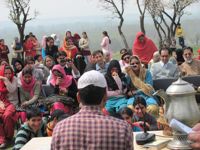Friday, April 19, 2024
News and Views from the Global South
INDIA: Kashmir in Search of Lost Culture
Athar Parvaiz
- While the conflict in Indian Kashmir and the destruction it has caused often makes the news, its impact on culture has hardly gotten any attention.

In an unusual scene, a university student performs before fellow students in Srinagar. Credit: Athar Parvaiz/IPS.
The Indian security establishment in Kashmir maintains that the number of insurgents and militancy- related incidents is far lower now than in the past: 474 incidents in 2010 as against 5,946 in 1995. Yet cultural activities, which used to be organised regularly before the onset of militancy in Kashmir in the late 1980s, are not taking place as expected. Officials of the Department of Art and Culture in Kashmir, however, say they have resolved to revive the rich tradition of cultural shows that were once Kashmir’s hallmark.
“Tagore Hall, the hub of Kashmir’s cultural and theatre shows, has been defunct for the last many years since no cultural activities have been held in this hall located in the heart of Srinagar City,” said Farhat Lone, Special Officer for Cultural Activities in Kashmir. “But we have now started renovating it because we are keen to see the revival of Kashmir’s rich art and culture.”
Lone said that since March, the cultural office has been organising talent hunt shows in various districts. The shows have drawn big audiences, reflecting Kashmiris’ love of art and culture.
Mohammed Maqsood was one of the performers at a recent cultural show at the Islamic University of Science and Technology (IUST) in Awantipora town, south-east of Srinagar. Maqsood sang Ladishah, which holds a significant position in Kashmir’s folklore. Ladishah is a sarcastic form of singing where the singer picks holes in the social and political system in a humorous manner. He was pleased that hundreds of students watched him perform and cheered profusely.
“This is the first time that I got an opportunity to perform. I am quite happy,” said 22-year-old Maqsood who grew up during the two-decade-old conflict.
“Art and culture should be de-linked from the conflict and should be allowed to flourish” said Gayas Akhtar, Maqsood’s fellow student. “Let us join hands and see this happening.”
Lone said this “erstwhile cultural glory needs to be restored” after the unrest of the last two decades that broke the back of the cultural prowess of Kashmir.
The unrest in Kashmir has its roots back in 1947, when India gained independence from Britain and the Muslim-dominated areas became part of Pakistan. In the meantime, a U.N. resolution gave Kashmiris the option to join either Hindu-dominated India or Muslim-majority Pakistan or to become independent. But Kashmiris had no chance to exercise their right to self-determination.
Roughly a third of modern-day Kashmir is administered by Pakistan while the rest is under India. But many Kashmiris challenge this and demand freedom from both countries. Pro-freedom people living on the Indian side rose up in arms in 1989 in an insurgency that simmers to this day. According to figures maintained by various government and non-government organisations, the number of people killed so far in the conflict is well over 50,000.
Since then, the Academy of Art, Culture and Languages, which used to organise cultural programmes in the Kashmir valley, has had to cease its operations. The curtains have closed on the big screens because of a blanket ban on movie theatres declared by the militants.
Researcher Bhawani Bashir says that although Kashmir has a long history of art and culture, “the 1980s were the golden period of Kashmiri Theater.” But things changed with the onset of turmoil in 1989 and its impact on art and cultural activities.
Zaffar Iqbal Manhas, who has long been associated with the Academy, says the bomb explosion in Tagore Hall in 1990 created fear and psychosis among artists.
“Apart from causing heavy damage to Tagore Hall, the explosion created a scare among the artists, and they hesitated to come forward to participate in activities like theatre shows or district drama festivals,” he told IPS.
A wrong perception about the Cultural Academy had spread, Manhas told IPS. “Almost 98 percent of the people in Kashmir were of the view that the activities of the Cultural Academy were anti-Islamic.”
This exposed the Academy and its employees to threats, he added. “I clearly remember that employees were hesitating to disclose that they were working with the Academy.” It is not only the Cultural Academy that suffered. Artists outside the institution were also reluctant to organise cultural events. Noted Kashmiri dramatist Mohammad Amin Bhat traces it to a “lack of confidence” to portray the truth.
“It takes moral courage to speak the truth,” he said, pointing out that artists have never tried to portray the conflict, which would have been well received by the people.
Bhat has produced plays which depict ground realities surrounding the conflict. These include “Naad” (Call), “Identity Card” and “White Paper”, which highlight the plight of the conflict-hit people of Kashmir.
“While talking about something, we don’t take sides; our plays are just artistic expressions or analysis of truth,” says Bhat. Public places where people used to converge have also lost their meaning because of the conflict.
“Kashmiris have seen their public places shrinking with meshes of barbed wire crisscrossing the roads, bunkers appearing everywhere and security men flaunting their weapons at every possible place like roadsides and street-crossings, or near schools, hospitals, shrines and tourist spots,” says human rights activist Khurram Parvez.
Kashmir watchers recall that in the initial years of the conflict, security forces occupied thousands of buildings and other public places, and burned down thousands more. “Gradually, many of the occupied buildings were vacated, but not all of them,” says Parvez.

 Print
Print



